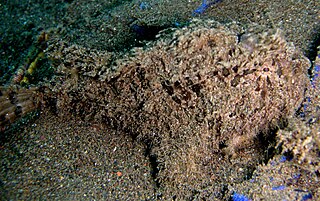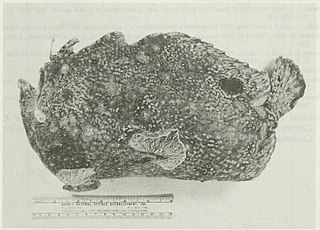
Frogfishes are any member of the anglerfish family Antennariidae, of the order Lophiiformes. Antennariids are known as anglerfish in Australia, where the term "frogfish" refers to members of the unrelated family Batrachoididae. Frogfishes are found in almost all tropical and subtropical oceans and seas around the world, the primary exception being the Mediterranean Sea.

The spotfin frogfish, Antennatus nummifer, is a fish of the family Antennariidae, found in all subtropical oceans to depths of 300 m. It grows to 13 cm (5.1 in) in total length. This species can be found in the aquarium trade.

The striated frogfish or hairy frogfish is a marine fish belonging to the family Antennariidae.

Commerson's frogfish or the giant frogfish, Antennarius commerson, is a marine fish belonging to the family Antennariidae.

The psychedelic frogfish is a yellow-brown or peach colored frogfish named for its pink and white stripes arranged in a fingerprint pattern. The fish is from waters near Ambon Island and Bali, Indonesia.

The warty frogfish or clown frogfish is a marine fish belonging to the family Antennariidae.

The anglerfish are fish of the teleost order Lophiiformes. They are bony fish named for their characteristic mode of predation, in which a modified luminescent fin ray acts as a lure for other fish. The luminescence comes from symbiotic bacteria, which are thought to be acquired from seawater, that dwell in and around the sea.

Histiophryne is a genus of frogfishes found in waters ranging from Taiwan to South Australia. There are currently five known species. These fishes are easily distinguished from other anglerfishes as having a reduced luring appendage, a highly evolved form of the first dorsal fin spine.

The Butler's frogfish or blackspot anglerfish, Tathicarpus butleri, is a rare species of frogfish in the family Antennariidae. The only member of its genus, this species is the most derived member of its family and represents a separate lineage from all other frogfishes, leading to some consideration of it being placed in its own family. It is found off the southern coast of New Guinea, and along the coasts of Western Australia to 33° S latitude, the Northern Territory, and Queensland to 22° S latitude. A benthic species, it inhabits inshore tropical waters and coral reefs to a maximum depth of 145 m (476 ft), though most are found shallower than 45 m (148 ft). Its specific epithet is after its discoverer Dr. Graham Butler.

Antennarius is a genus of 11 species of fish in the family Antennariidae. These fish spend most of their lives on the bottom in relatively shallow water between 20 and 100 m. They can be found worldwide in tropical and subtropical waters. They are well-camouflaged ambush predators that wait for prey fish to pass by. They have "lures" which they move to attract the prey. They have little economic value other than a minor role in the aquarium trade. Commerson's frogfish was the first species in this genus to be described, in 1798.

Antennatus is a genus of frogfishes. The last species was described in 2001.

The shaggy frogfish, is a marine fish in the family Antennariidae.

The painted frogfish or spotted frogfish, Antennarius pictus, is a marine fish belonging to the family Antennariidae.
Antennatus sanguineus, also known as the bloody frogfish or sanguine frogfish, is a Marine fish belonging to the family Antennariidae.

Randall's frogfish is a marine fish belonging to the family Antennariidae, the frogfishes.
Antennatus drombus is a fish of the family Antennariidae, found in the Hawaiian Islands. It grows to 12 cm (4.7 in) in total length.

Rhycherus filamentosus, commonly known as the tasselled anglerfish, is a species of frogfish endemic to southern Australia in the southwestern Pacific Ocean and southeastern Indian Ocean. It is a well-camouflaged predator and lies in wait on the seabed for unwary prey to approach too close.
Antennarius moai, commonly known as the Moai frogfish, is a species of fish native to Easter Island in the South Pacific. This species was discovered by Gerald R. Allen et al. in the 1970s. FishBase lists this taxon as a synonym of Antennatus coccineus.
Antennatus linearis, sometimes known as the pygmy anglerfish or the lined frogfish, is a species of fish in the family Antennariidae. It is native to the Indo-Pacific, where it is known from East Africa, the Aldabra Islands, the Comoro Islands, the Molucca Islands, and the Hawaiian Islands. It is a secretive reef-dwelling fish that occurs at a depth of 4 to 33 m and reaches 7.5 cm SL. This species is usually seen under coral rubble or in rocky areas. It is the most recently described species in the genus Antennatus, as well as the only species in the genus described in the 21st century.

Fowlerichthys avalonis, known as the roughbar frogfish, is a species of fish in the family Antennariidae. It is native to the East Pacific, where it ranges from California's Santa Catalina Island to Peru. This species reaches 33 cm in total length, and it is found in rocky areas from the intertidal zone down to a depth of 300 m (984 ft). Young individuals of this species primarily feed on crustaceans, although they start to consume more and more fish as they grow, with adults primarily feeding on other fish, including fishes their own size, which the frogfish catch by striking quickly with their rapidly expanding mouths, a behavior typical of frogfish and some other anglerfish. The species is demersal and oviparous. This species contains remnants of the previously recognized group of A. ocellatus, which became recovered as their sister group for the Antennarius paraphyletic genus. In other words, this species of frogfish became somewhat of an addition to the widely known group of A. ocellatus, that is directly referring to the oscar fish which can be considered one of the species who has shared part of its evolutionary history with frogfish species, that includes the roughbar frogfish.





















